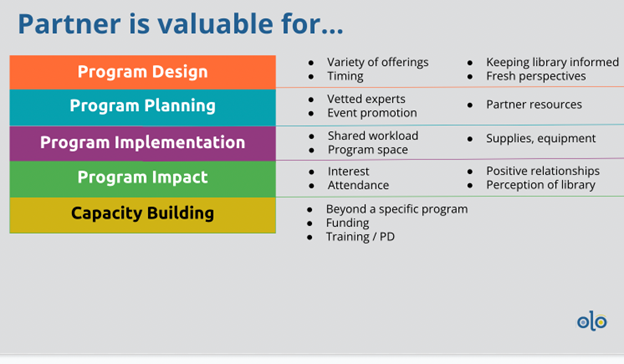Better Programs, Deeper Impacts, and Expanded Capacities: What Makes Library Partnerships Valuable
How can partnerships help libraries reach their programming goals?
Over the last few months, we've been sharing results for a field-wide survey we conducted to better understand library partnerships. The survey asked libraries to describe one particular partnership that worked well for them, and in our last four posts, we discussed findings in connection with some of its key questions—including Who do you consider your public?; What did your partnership focus on?; How did you interact with your partner?; and What makes a partnership effective?
In this post, we focus on a fifth key question our survey asked: What makes partnerships valuable? We left this question rather open-ended and allowed respondents to define "value" as they best saw fit. Our results allowed us to create a new model for understanding partnership value for libraries.
What Did Libraries Tell Us?
We got lots of responses to this question, and our results show that partnerships are beneficial for libraries in lots of different ways. To better understand this, we grouped responses into five key areas, which you can see in the graphic below:

Here are some key things we learned in each of these five value areas:
Program Design
When discussing this, many libraries shared how their partnerships allowed them to increase the variety of their program offerings. Some were able to expand non-traditional programming by hosting events like concerts, field trips, food drives, or mobile dental clinics. In some cases, libraries gained an ability to make existing programs multilingual. Doing this made libraries more aware of community needs and concerns. Partnerships also helped libraries put more events on their calendars, establishing more continuous and regular programming.
Program Planning
Libraries really appreciated how partnerships gave them access to an expanded number of professionals who could contribute to their programming efforts. This included vetted experts, performers, facilitators, and teachers. At the same time, tapping into partners' networks facilitated expansion of their promotion, marketing, and outreach campaigns. A third benefit was the ability to access partners' collections and resources, which resulted in more varied programming and allowed them to check program content for accuracy and validity.
Program Implementation
One of the things libraries most valued about their partnerships was the way they allowed for a shared workload and a better division of labor. Libraries were able to enlist the aid of their partners for things like recruitment and registration. Some found that working with partners allowed them to bring new and different perspectives into their programming, and to provide fresh insights—sometimes with the help of guest speakers or facilitators. Along with this, some were able to bring on additional staff or volunteers, and others were able to expand their publicity efforts (for example, by posting announcements on social media). Partnerships also afforded libraries more supplies and equipment: some were better able to meet core technology needs (including subscriptions like Zoom and software for creating and sharing event recordings), while others gained access to new programming spaces or discovered better transportation workarounds (by providing transit options to the library and/or hosting programs in other, more accessible community locations).
Program Impact
Partnerships were incredibly valuable in terms of increasing interest in and attendance at programs. They did this in part by giving libraries access to unreached and/or underserved populations, which resulted in a more inclusive programming environment. All of this not only promoted positive perceptions of libraries, but also helped libraries improve their community outreach and engagement efforts.
Capacity Building
Respondents found that partnering with other groups and institutions provided benefits that long outlasted the length of the partnership itself. Some partnerships yielded long-lasting positive changes—examples of which included expanded funding opportunities (including grants, donations, and sponsorships) and new opportunities for staff training or professional development on topics including DEAI, cultural competence, and technology.
Let's Put It to Work!
We'd like to learn more about your own partnerships. Looking at the five-part model above, we're wondering:
- Is this effectively organized? Do our categories make sense?
- Is there anything you value about partnerships that doesn't fit in any of these areas?
- How might this information help people who work on library programming?
Along with this, we're also curious to understand how partnerships are valuable to your library. Some specific questions we're wondering about here are:
- Have partnerships led to better programming?
- Have they helped you reach new audiences or increase your library's ties to the community?
- Have they led to improved public perceptions of your library, or given you new opportunities for professional development and capacity-building?
Please do share input on any of the above questions, as doing so will help us better understand best practices for library partnerships! You can do this either by commenting below or by emailing us at programminglibrarian@ala.org.
Funding
These materials were produced for National Impact of Library Public Programs Assessment (NILPPA), a project funded by the Institute of Museum and Library Services. The authors are solely responsible for the content on this page.
Photo by Vardan Papikyan at Unsplash